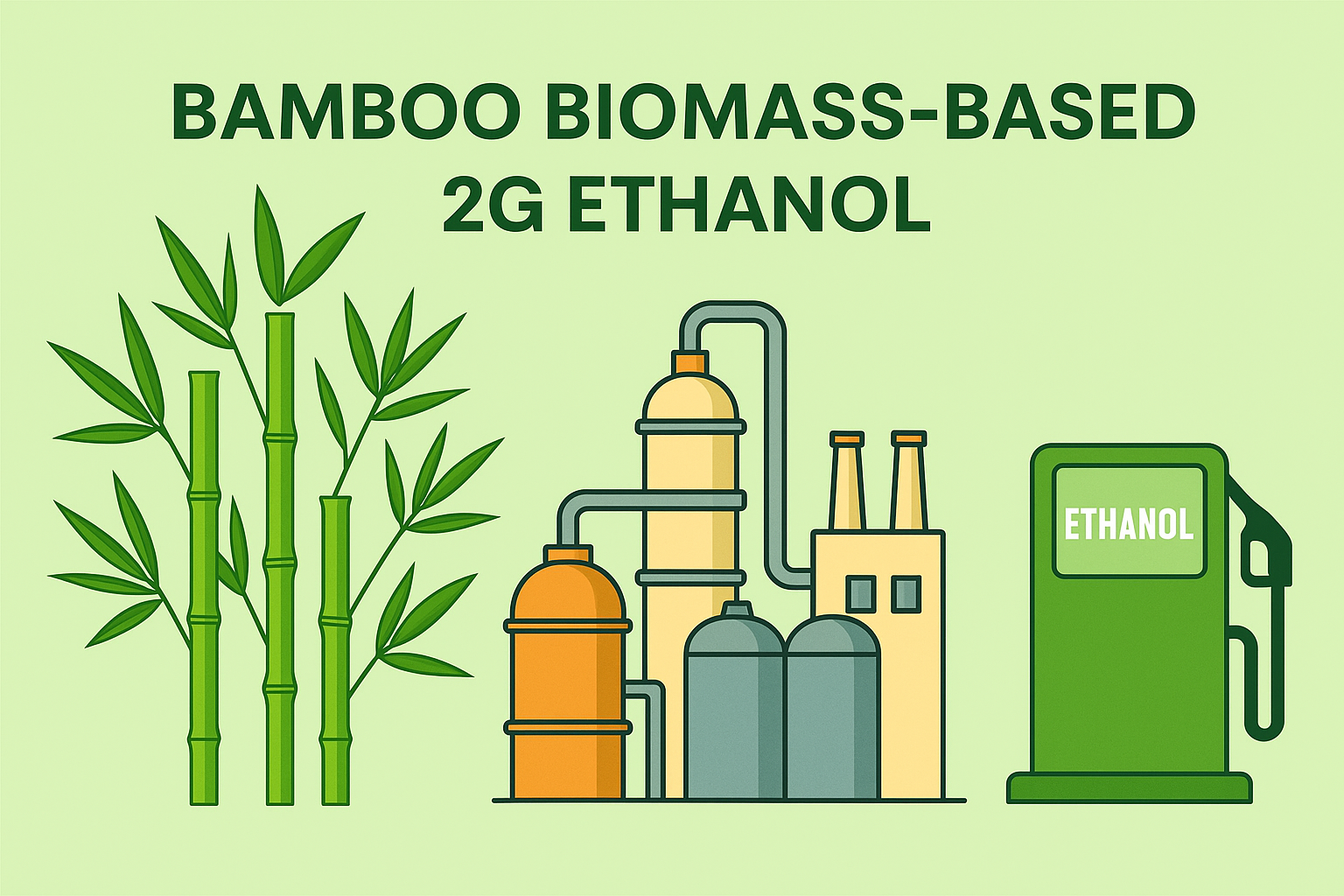As the world transitions to more sustainable energy sources, ethanol has emerged as a key biofuel that can significantly reduce dependence on fossil fuels. Within the bioethanol sector, a clear distinction exists between first-generation (1G) and second-generation (2G) ethanol. While 1G ethanol has been around for decades and is derived from food crops like sugarcane and maize, 2G ethanol offers a more sustainable and scalable future by utilizing non-food, lignocellulosic biomass, such as crop residues, wood, and bamboo. Among these, bamboo is gaining increasing attention, particularly in India, for its unique combination of availability, renewability, and environmental benefits.
1G vs 2G Bioethanol: What’s the Difference?
The fundamental difference between 1G and 2G ethanol lies in the type of feedstock and the complexity of the production process. First-generation ethanol uses sugar- or starch-rich crops that are easy to ferment. The production process is straightforward and relatively low-cost but comes with the downside of competing with food resources, leading to the food-versus-fuel debate.
In contrast, second-generation ethanol is produced from lignocellulosic biomass, non-food materials such as agricultural residues, wood chips, or bamboo. The production process is far more complex, involving intensive pretreatment to break down cellulose and hemicellulose into fermentable sugars. However, the key advantage is that it uses waste or underutilized biomass, avoiding direct competition with food production and offering better carbon reduction potential.
Ethanol from Grain Biomass vs Bamboo Biomass
While both grain-residue and bamboo fall under the 2G ethanol category, the processing nuances are significant. Grain-residue ethanol typically comes from wheat straw or corn stover and follows a moderately complex process involving pretreatment, enzymatic hydrolysis, fermentation, and distillation.
Bamboo-based ethanol, however, requires more intensive pretreatment due to the dense lignin and crystalline cellulose structures. The bamboo must be chopped, pretreated chemically or through steam explosion, and then hydrolyzed enzymatically. The resulting sugars are then fermented into ethanol. This process may also produce valuable by-products like acetic acid and furfural, which enhance the plant’s overall profitability.
Input-Output Analysis: How Does Bamboo Measure Up?
When comparing the ethanol yield from grain biomass and bamboo, both fall within a similar range under optimized conditions. Typically, one tonne of dry straw yields around 200 – 300 liters of ethanol. Bamboo biomass offers comparable results; India’s new bamboo ethanol plant in Assam is projected to use 300,000 tonnes of bamboo annually to produce approximately 62 million liters of ethanol, around 206 liters per tonne of bamboo. This shows that with the right technology; bamboo can be as efficient as traditional grain-based feedstocks.
Bamboo Availability in India: A Strategic Advantage
India is blessed with vast bamboo resources, especially in the northeastern states. Over 66% of the country’s bamboo forest cover is concentrated in this region, offering an underutilized and renewable resource base. The Indian government has also amended the Indian Forest Act to ease the cultivation and harvesting of bamboo on non-forest lands, thus removing significant regulatory hurdles.
The Assam ethanol project, for example, has plans to distribute millions of bamboo saplings to local farmers, creating a vertically integrated supply chain. This approach not only ensures consistent feedstock availability but also promotes rural livelihoods.
Is the Technology and Plant Feasible?

India’s first bamboo-based ethanol plant, inaugurated in Assam, is a technological milestone. Developed with Finnish technology from Chempolis and supported by Numaligarh Refinery Ltd (NRL), the plant integrates production of ethanol with co-products like acetic acid, furfural, and green electricity. This multi-stream output makes the project financially more robust.
The technology has been vetted for industrial-scale operation, and its feasibility hinges on efficient pretreatment, enzyme management, and integrated by-product recovery. While high capital investment and technical risks exist, the project design minimizes these through process optimization and feedstock security.
Difference in Machinery and Equipment
While both grain and bamboo biomass ethanol plants share core units like fermenters and distillation columns, bamboo ethanol requires additional and specialized equipment. For instance, bamboo’s fibrous texture necessitates heavy-duty chippers and shredders. Pretreatment reactors for bamboo also need to be more robust, often operating at higher pressure and temperature.
Furthermore, equipment for detoxification, solid-liquid separation, and lignin handling needs to be designed specifically for bamboo’s unique characteristics. These additional requirements do raise capital costs but are essential for maintaining process efficiency and yield.
Minimal Viable Scale for Commercial Sustainability
Second-generation ethanol production is capital-intensive, making scale a critical factor for economic feasibility. The Assam bamboo ethanol plant serves as a benchmark, operating at 300,000 tonnes of input biomass per year and producing around 62 million liters of ethanol.
Based on current technology and economics, a minimal viable scale for bamboo ethanol plants would likely be in the range of 20–50 million liters per annum. Plants smaller than this may struggle with high fixed costs and operational inefficiencies unless supported through government grants or technological breakthroughs.
Global Perspective on Bamboo Ethanol
Globally, the use of bamboo for ethanol production is still in its infancy. While countries like China, Brazil, and some in Southeast Asia have explored bamboo for energy and chemicals, large-scale ethanol production remains limited. India’s initiative is among the first commercial-scale endeavors and could serve as a model for other bamboo-rich nations.
With global attention shifting toward sustainable and low-carbon fuels, the successful deployment of bamboo ethanol plants in India could catalyze similar projects worldwide.
Future Prospects and Growth Potential
The prospects for bamboo-based 2G ethanol are promising. India’s ethanol blending targets (E20 by 2025) create strong demand certainty. Technological advancements in enzyme efficiency, pretreatment methods, and by-product valorization can further improve project economics.
Moreover, the environmental benefits – reduction in greenhouse gas emissions, rural employment, and waste biomass utilization, align with broader sustainability goals. If early projects like the Assam plant prove successful, private and public investment in this sector is likely to increase rapidly.
Private Sector Considerations
For private players evaluating entry into bamboo ethanol, a few strategic considerations are essential:
- Securing long-term feedstock contracts with farmers or cooperatives
- Investing in proven pretreatment and hydrolysis technology
- Building multi-product value chains to monetize lignin and other residues
- Engaging in public-private partnerships to leverage government support
- Factoring in logistical challenges, particularly in hilly bamboo-growing regions
A well-structured business model that includes offtake agreements, process integration, and diversified revenue streams is crucial for success.
Incentives and Policy Support from the Government of India
The Indian government has been proactive in supporting biofuel initiatives. Under the National Policy on Biofuels and schemes like Pradhan Mantri JI-VAN Yojana, financial incentives are available for 2G ethanol projects. These include capital subsidies, viability gap funding, and tax benefits.
The ethanol blending program further ensures a guaranteed market. Additionally, the recent DGFT notification allowing exports of 2G ethanol with authorization adds an extra revenue stream for producers. State-level incentives in bamboo-rich areas, such as land grants and power subsidies, further strengthen the case.
Conclusion
Bamboo-based 2G ethanol represents a significant opportunity for India to lead in sustainable biofuels. With abundant raw material, evolving technology, supportive policy, and growing demand, the path is set for scaling up production. While challenges remain in capital cost, technological complexity, and supply chain management, these can be overcome through innovation, partnerships, and strategic planning.
The success of the Assam bamboo ethanol plant will serve as a critical litmus test. If proven viable, it will not only boost India’s biofuel economy but also set a global precedent for leveraging bamboo, a fast-growing, renewable, and underutilized resource, for clean energy production.
At HMSA, we specialize in helping entrepreneurs, investors, and businesses navigate the complex world of biofuels and renewable energy. Whether you’re exploring bamboo biomass-based 2G ethanol or any other sustainable venture, our team is equipped to deliver comprehensive project reports, feasibility studies, and market assessments tailored to your specific goals. We empower you with the insights and clarity needed to make informed, confident investment decisions in this fast-evolving sector.
Also Read: India’s BioE3 Policy: Boosting Bioethanol Production with Enzyme Manufacturing
